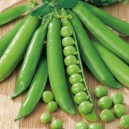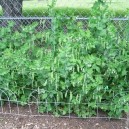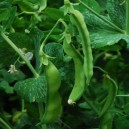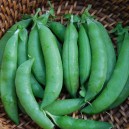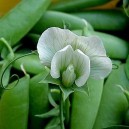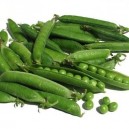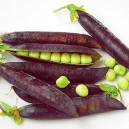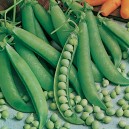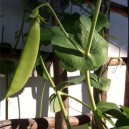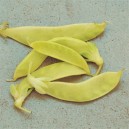
Welcome, Log in
Product Categories
-
Heirloom & OP Seed
- Cool Weather Crops
- Warm Weather Crops
- Beans
- Beetroot
- Brassicas
- Carrots
- Chard
- Corn/Maize
- Cucumbers
- Eggplant (Aubergine)
- Leeks
- Lettuce
- Melons
- Okra
- Onions
- Parsnips
- Peas
- Peppers & Chillies
- Radish
- Spinach
- Squash & Pumpkins
- Tomatoes
- Turnips
- Unusual / Exotic
- Herbs & Spices
- Fruits & Berries
- Value Packs
- View All Seed
- Gift Vouchers
PeasThere are 10 products.
Please scroll down or click here to view the product list
GROWING INSTRUCTIONS FOR PEAS
Binomial Name: Pisum sativum
Varieties: Sugar Snap, Sugar Ann, Kelvedon Wonder, Purple Podded, Little Marvel, Oregon Sugar Pod II, Tall Telephone
Start: Seeds
Germination: 9 - 13 days, 5°C to 30°C
Seed Life (viability): 3 years
Soil: Well drained
Sunlight: Full sun, part shade
Sow Seeds: 3 to 10 cm apart
Transplant Seedlings: 3 to 10 cm apart
Ave. Days to Harvest: 54 to 72
Good Companions: Beans, beets, cabbages, carrots, corn, cucumber, dill, fennel, lettuce, sage, yarrow
Bad Companions:Cauliflower, garlic, leek, onion, potato, shallots, tomato
Note: Snap peas, also known as sugarsnap peas, are a cultivar group of edible-podded peas that differ from snow peas in that their pods are round as opposed to flat. The name mangetout (French for "eat all") can apply both to snap peas and snow peas. The snow pea pod is eaten flat, while in sugar/snap peas, the pod becomes cylindrical, but is eaten while still crisp, before the seeds inside develop fully. Garden peas are also known as 'shelling' peas and only the pea seeds themselves are eaten after shelling.
Sowing & Planting: Like sweet corn, peas are at their tastiest immediately after harvest. Whether you choose shell or edible-pod peas, they grow best during cooler weather (early spring and late autumn/early winter) when temperatures are between 15°C to 20°C. Yields best in full sun.
Prefers well-drained soil, average fertility, high in organic matter with pH 6.0 to 7.0. Widely adapted, but prefers cool, damp weather. Good soil structure is important. Avoid compacting soil by working it when it’s still too wet. Leafless varieties have particularly fine texture.
Sow seed direct. Peas planted in cold soil (5°C) are slow to germinate. Later plantings made when the soil is warmer (15°C or more) often catch up quickly with earlier plantings. Use raised beds if your soil is slow to drain. Make additional plantings early in the season, or plant varieties with different maturity dates to increase the harvest period.
Plant seeds 3 to 5 cm deep, 3 to 10 cm apart in rows 45 cm apart. Shallow planting is best when soils are cool and wet. Plant deeper if soil is dry. A quick way to seed is to make a furrow or trench with a hoe, place seed in the furrow, cover and firm. Do not thin.
Growing: Erect trellis for tall-growing, vining types at planting using chicken wire, brush or other suitable trellis material. If trellising, increase row spacing to 1.2 to 1.8 m. Keep soil moist, but avoid heavy watering during flowering, which can interfere with pollination.
Intercrop peas with fast-growing cool-season crops such as spinach or radishes. Sow autumn crops about 8 to 10 weeks before first frost date. Autumn crops can be disappointing if hot weather persists. Powdery-mildew-resistant varieties are best for autumn crops.
Do not use high-nitrogen fertilizers. Too much nitrogen will result in lush foliage but poor flowering and fruiting. Do not plant peas in the same place more than once in every 4 years. Avoid planting where in places where peas have suffered before from root rot.
Harvesting: Pea pods usually measure anywhere from 4 to 15 cm. They are best harvested when they are slightly immature as this will give you the sweetest taste. The peas that are ready first will be located at the bottom of the plant and once they are ready start picking because this will encourage the plant to produce more. You will know they are ready when the pod looks green, shiny, and puffy and you pinch the pod you can feel fully formed round fruit.
To pick peas hold on to the pod with one hand and vine with the other and tug it off. They tend to want to hold on to the vine so make sure you don’t tug the vine out of the ground. If you are growing snow or snap peas, make sure to pick them before the peas inside the pod fill out as their sweetness diminishes as the seed grows. Snow peas should be harvested when the pods are still flat.
Peas quickly loose their sweetness after harvesting so make sure to use them immediately. If you don’t need them right away make sure to freeze them to preserve their flavor.
-
R 25.00Out of Stock More Details
Coming Soon -
R 25.00Out of Stock More Details
Coming Soon -
R 25.00Add to cart More Details
Available -
R 25.00Out of Stock More Details
Coming Soon -
R 25.00Out of Stock More Details
Coming Soon -
R 25.00Add to cart More Details
Available -
R 25.00Add to cart More Details
Available -
R 25.00Out of Stock More Details
Coming Soon -
R 25.00Out of Stock More Details
Coming Soon -
R 25.00Out of Stock More Details
Coming Soon
